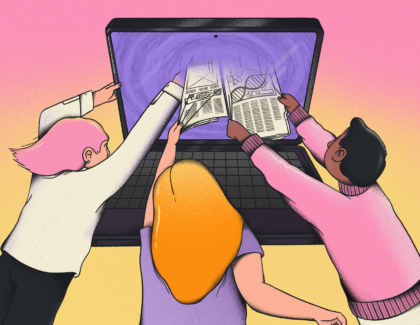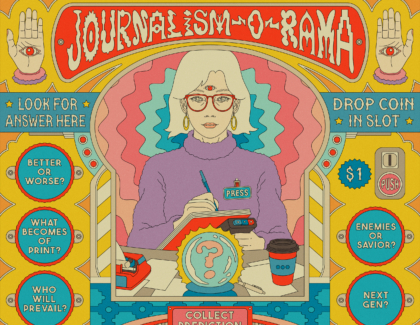Sign up for the daily CJR newsletter.
Last Tuesday morning, Wally Skalij, a staff photographer at the LA Times, was walking his dog along on the beach when he saw a plume of smoke rising in the distance and thought to himself, Here we go. Skalij took his dog home, suited up in specialist gear, and drove out to the Pacific Palisades neighborhood, where roads were jammed as residents tried to flee an encroaching wildfire; he took some photos and sent them to his editors, despite weak cell service. Later, he went down to the Pacific Coast Highway in Malibu. “I’ve covered fires in Malibu before, and usually fire comes down the hill slowly,” he recalled to my colleague Feven Merid, “but this one just came in so fierce”—whipped by ferocious wind that, at one point, blew a gust of embers in Skalij’s direction, forcing him to take cover. “I was shocked,” he told Merid. “I’ve seen a lot of fires. I’ve never seen wind like this sustained for so long.”
Skalij, of course, is just one of a number of local journalists who have covered the fires as they have devastated large swaths of the LA area since then. (As of this morning, at least twenty-four deaths had been linked to the fires while more than twelve thousand structures had been reported destroyed, according to the LA Times—with more wind on the way and no end yet in sight.) Those on the ground have faced dangers, from the high wind speeds to dirty air, and sometimes borne painful personal costs: one local TV journalist, Enrique Chiabra, walked off set after reading an evacuation order on air and realizing it covered his own home; another, Josh Haskell, covered the orders while texting with his parents about what they needed to do; just before Skalij spoke with Merid, he learned that a fellow photojournalist had lost their home. (These journalists’ employers have also borne very literal costs: the LA Times dropped its paywall around fire coverage; according to Variety, one local TV station estimates that it has taken “a six-figure hit or more” in overtime for staff and lost ad revenue as broadcasts have gone without commercial breaks.) There have also been numerous stories of journalists helping others in their community, be that by sharing information directly or, in at least two cases, rescuing animals—dogs, ducks, chickens—from threatened homes. KCRW, a local public radio station, pledged to call up any residents who might want to “talk to someone for comfort,” to offer them support or just to listen.
Journalists from major national outlets have been on the ground, too. This is to be expected, of course, but unlike with typical disaster scenes, where big national names parachute in briefly then fly out again, some of these journalists have themselves been reporting on their own communities since they live in or have roots in LA—which is, after all, a media hub, if not to the extent of, say, New York. ABC’s Matt Gutman was reporting from outside a gutted home in Pacific Palisades during a segment on The View when he revealed, almost in passing, that the property belonged to his aunt; back in the studio, there were audible groans of sympathy. On NBC, Jacob Soboroff stood outside the rubble of his childhood home, taking in the scene with a grim expression before calling his mother. Pacific Palisades feels like “a tiny town anywhere in the United States,” Soboroff reflected later. “There’s something beautiful about being here, in a place I know so well, using the tools that I’ve learned on this job to help share this story.… In a way, doing this job is part of my grieving experience for the Palisades.”
Perhaps more so than usual, coverage out of LA in recent days has thus had a powerful immediacy—its creators’ personal investment in it augmenting the already shocking images of roaring flames and razed neighborhoods. This is not to say that the coverage as a whole has been beyond critique, however. There has been some parachutism. (David Muir, the anchor of World News Tonight, was widely mocked online after appearing to use clothespins to make his fire-safety jacket fit tighter; an “insider” quipped to Page Six that Muir “forgets he is the face of ABC News, not Abercrombie & Fitch!”) And Pacific Palisades is not exactly like a tiny town anywhere in the US: lots of celebrities live there and in other affected parts of LA, and many of them have cropped up in coverage. Sometimes, their presence has helped, at least implicitly, to underline the sheer inescapability of climate disaster. (The actor Eugene Levy spoke to the LA Times in his capacity as honorary mayor of Pacific Palisades.) But some coverage of the impact on the Hollywood elite—and their premieres and promo tours—has felt clickbaity or trivial or prurient, or some mix thereof. (Certain paparazzi have not put down their cameras during the fires. Vulture’s Chris Lee asked two industry sources for their reaction: one praised the paps for getting a big story; the other called them “fucking idiots” looking to make a quick buck.) “A lot more people than just celebrities are affected,” Joe Flint, a media reporter at the Wall Street Journal, noted on X last week. Centering the latter in coverage “makes the rest of the country think, oh well they can just go to their second homes.”
And, while a good deal of coverage has interrogated the role of climate change in spurring the fires, not all coverage has done so. (It’s hard to state conclusively that climate change caused a particular extreme weather phenomenon, especially in the moment—but in general, it’s well established that it makes such phenomena more likely and more severe, and that has been the case this time.) Some articles and segments on the fires haven’t even mentioned the climate link—echoing a long-standing problem of climate coverage being siloed from breaking-news reporting on disasters (which I’ve written about before in the context of wildfires in California). Stories like the recent fires are too often “framed as tragic but random events—acts of nature without clear cause or accountability,” Margaret Klein Salamon, the executive director of a group that supports nonviolent climate activists, argued in Rolling Stone yesterday. “Even if articles do mention climate change, which they tend to bury toward the end, they won’t tell you the people and companies who caused these disasters in order to enrich themselves.” Again, much recent coverage has drawn the link clearly—but we are now surely at a stage where this should be the case in all coverage, or something close to it. This isn’t a question of piety or tokenism, but of which facts we consider to be the ubiquitous, unquestioned building blocks of our stories.
If the recent coverage and the critiques of it can be seen through lenses that are, by turn, common to extreme weather events and specific to LA’s social makeup, the debate around the media and these fires has also been informed by the present state of our shared information climate—powerful on-the-ground journalism is all well and good, but what’s it worth if people don’t believe or even consume it? As the fires spread, so did a barrage of increasingly ludicrous right-wing narratives about them on TV and online: that climate change isn’t so much to blame for them; that actually, they are an example not of climate change but of “climate same”; that homeless people likely started the fires; that they are part of a “large globalist plot”; that California’s woke leaders prioritized diversity initiatives over keeping people safe; that “Governor Gavin Newscum” failed to sign a supposed “water restoration declaration” to protect “an essentially worthless fish called a smelt.” We’ve seen this sort of thing before, too, except this time, the latter line and others have been amplified by the incoming president of the United States; this sort of thing isn’t new either, of course, but this has at least felt like the first natural disaster of the second Trump era, a period so far marked by media uncertainty as to how aggressively to cover his behavior, and submission to his desires on the part of the tech titans responsible for regulating online discourse. On Saturday, Newsom wearily told Soboroff that responding to Trump’s insults would take a month. He set up a webpage, linked to his campaign site, debunking some of them.
Trump’s victory also supercharged a sense that the traditional news media has lost what remained of its purchase on America’s information ecosystem, which, the same theory goes, is now a lawless, noisy, and fractured place where anything goes and individual content creators run amok. The LA fires might be seen, if not as the first natural disaster under this informational landscape, then the first during this moment of heightened anxiety about it—and so it’s unsurprising that some commentary has seen the fires through this lens, too. The fires have “exposed a ravaged Los Angeles media ecosystem,” Janice Min, the CEO of the entertainment-news site The Ankler, wrote in Semafor yesterday. “In my multiple text chains was the constant question: What’s the best place to get information? The answers were a hodgepodge of new apps and websites (Watch Duty! Genasys! Wildfire Viewer!), Google Docs shared by neighbors about what burned down, rogue drone footage, and Instagram Reels. Not once did anyone cite a Los Angeles media outlet, save for old-school local broadcast news channels, primarily watched through their websites—a heroic resource for seeing footage, catching the latest and hearing press conferences.” LA, Min added, “is always on the knife’s edge of natural disasters. Now the raging fires in the second-most populous city in America have exposed a manmade disaster: an information wasteland.”
Not that everyone would agree with this assessment; at least, not in its entirety. “I actually found local news to be very helpful during the last week. LA Times, public radio, local TV, blogs. They all led the way in coverage,” Bloomberg’s Lucas Shaw responded on X. “Turning to social media and other news sources is a fundamental part of our reality now. Not a sign of weakness.” In his newsletter on Substack, meanwhile, Matt Pearce, a former LA Times reporter, wrote that while “traditional journalism may be less visible in the foreground of a user-populated information environment, it’s still playing a critical role in trying to keep the information economy properly fed and cared for.” He also suggested that Watch Duty—a free app offering practical information about the fires that has, in Pearce’s words, been “the breakout resource of this disaster”—is a form of journalism, in that it meshes “publicly available data with a team of trained reporters following an editorial code of conduct.”
If the LA fires have underscored concerns about the health of our information climate, in addition to our physical one, then they should also serve as proof that the public need for timely, fact-based information is not going away—even if the mechanics of its distribution are currently in flux—and that traditional newsrooms still have the mettle to provide it in the literal heat of a crisis. Of course, gathering fact-based information is expensive, and the traditional media business is in decline. But this need not be inevitable. As Pearce notes, while the fires raged late last week, Newsom’s administration “quietly proposed setting aside $30 million in state funds to support local journalism jobs in California”—part of an agreement that was struck last year, under the terms of which the state will funnel money to newsrooms in partnership with Google. Pearce and others have criticized the bill for not going far enough. In his newsletter, he described the fires as a “unique opportunity” for state lawmakers to reckon with and improve California’s “chaotic information environment” going forward—by supporting “the labor of journalism rather than this or that business,” and thus boosting “legacy local newsrooms and new Watch Duty places alike.”
For now, journalists on the ground continue to report despite the litany of challenges facing them, physical and otherwise. Skalij, the LA Times photojournalist, told Merid that at one point, he was working on the Pacific Coast Highway when everything went dark amid choking black smoke. “I sat there for like ten, fifteen seconds, just sitting there in black,” he said. “It scared me, because I didn’t know if there’s a fire coming or if something was going to fall.” His work this past week has involved documenting people’s “worst moment,” he said—and yet he told Merid that, overall, “I don’t look at it in a negative way. I look at it as a positive. Maybe we can learn from this. That’s one of the reasons why I’m out there.”
Other notable stories:
- On Friday, the Supreme Court heard an appeal against a law, passed last year with bipartisan backing, that would ban TikTok in the US if ByteDance, the app’s Chinese parent company, doesn’t sell it—less than ten days before the ban is due to take effect (on the day before Trump returns to office). A decision in the case has yet to be announced, but Court-watchers seem to agree, based on the justices’ lines of questioning, that they appear poised to uphold the law; lawyers for TikTok and a collection of users who create content on the app argued that the law violates the First Amendment, but the justices seemed skeptical of this claim and broadly more favorable to the government’s national-security-based justifications. (They also seemed skeptical of a last-ditch effort by Trump to punt the question into his term.)
- Also on Friday, Mark Zuckerberg—the CEO of Meta, who announced earlier last week that his company will radically overhaul its approach to content moderation, including by ending partnerships with third-party fact-checkers—did a lengthy interview on Joe Rogan’s popular podcast, during which he likened Meta’s previous fact-checking practices to something out of 1984, slammed the Biden administration for what he described as aggressive requests that the company take down certain posts about COVID-19, and took aim at the media for supposedly hounding him about misinformation. Meanwhile, Axios reported that Meta has moved to terminate major diversity, equity, and inclusion initiatives—long a right-wing boogeyman.
- Reckon News—a newsroom under the umbrella of the local publishing group Advance that focused on reckonings around race, climate justice, and other topics—is shutting down and laying off eleven staffers, in what The Objective describes as the latest sign that media companies are deprioritizing such coverage. (Two of its products will survive, along with two staffers.) In other media jobs news, Semafor reports that Vox Media made layoffs last week, and that cuts are coming to This American Life—a rare step for the popular podcast. Also per Semafor, Chuck Todd, the former host of Meet the Press, is now planning to quit NBC altogether.
- The Washington Post’s David L. Stern explored the new media strategy of Volodymyr Zelensky, the president of Ukraine, who has turned to alternative media personalities in the US to get his message out following Trump’s victory; recently, he sat for a “three-hour, expletive-laden interview” with the podcaster Lex Fridman, who traveled to Kyiv for the discussion. Zelensky “wants to communicate with those people who convey the maximum amount of information to the maximum number of listeners, and the maximum number of the American people,” an official said.
- And the AP’s Melanie Lidman reports on how Moshe Nussbaum—a prominent TV journalist in Israel who gradually disappeared from screens after he was diagnosed with amyotrophic lateral sclerosis, or ALS, a progressive disease that makes movements and speech difficult—is now returning to the air with the help of AI. Per Lidman, he “will report his stories, and then write them up, using an AI program that has been trained to speak using Nussbaum’s voice. He will be filmed as if he were presenting, and his lips will be ‘technologically adjusted’ to match the words.”
Update: This piece has been updated to clarify the nature of an agreement between the state of California and Google for funding local news.
Has America ever needed a media defender more than now? Help us by joining CJR today.







